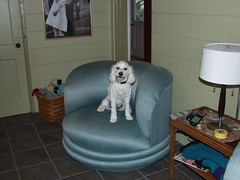WhiFinCog
For Whittaker-Finch-Cognetti Family & Friends To Blog Till They Can Blog No More!
Thursday, March 31, 2005
Saturday, March 26, 2005
The days when the Myrtles were young
A reader pointed me to this commentary from NPR's "All Things Considered" on "names with backbone." The commentator begins by noting an odd phenomenon. Reading the obituaries he sees the same names "over and over again," names like Opal, Ethel and Hazel. He describes those names as an entire generation like "The Boy Named Sue" -- parents choosing unstylish names in order to toughen up their kids. In parallel, he suggests that baby boomers who gave their kids stylish names were coddling them. Here's an excerpt:
"There was a time when moms and dads didn't worry about whether their children were popular. They were more concerned about whether their kids had enough to eat. Parents wanted sturdy, rugged children so they gave them sturdy, rugged names. But as times got better, parenting had less to do with feeding children and more to do with nurturing their self esteem."
Names like Opal and Hazel will come back, he claims, "when we decide we've spent too much time sheltering our children, and we want them to grow up resilient and ready to fend for themselves, just like the boy name Sue."
At this point you might stop to wonder: how could an entire generation have be given the same unpopular names, "over and over again"?
Fashion is a subtle, pervasive force that shapes our impressions of the world. The commentator, who like most of us lives in the present, hears names like Opal as sturdy and unfashionable. He hears this so surely and vividly that he applies it to the motivations of parents 100 years ago. They chose names that sound sturdy and rugged, thus they wanted their children to lead sturdy, rugged lives. Right?
Travel back in time with me for an exercise of the imagination: let's try to hear Opal as the parents of a century ago heard it.
In the 1880s America was a largely agricultural country, and names like Mary and Margaret, John and George still dominated America's nurseries. But a new wind was blowing. Cities were growing, waves of immigration were transforming the country, and a new generation of names grew with it. From 1890 to 1920, as modern America was born, the new names parents chose were paved with gold.
For boys, parents chose glittering dreams of aristocracy. Alongside John and George, we saw boys named with the surnames of the upper crust -- Milton, Sidney, Whitney. Germanic names were also popular for both sexes, their dense continental sound as rich as velvet. And for girls we had names like jewels, delicate symbols of nature's beauty. The botanicals: Lily, Rose, Hazel, Myrtle. The gems: Amber, Ruby, Jewel, Opal. They were an gossamer vision of femininity, ready to be put on a pedestal. Talk about "nurturing their self esteem." Just hear the grandparents of the time grumbling: "Opal? What kind of fancy-pants name is that?"
Back to the present now. Can you imagine saying that parents chose names like Amber, Lily and Jewel because they wanted their daughters to be "sturdy"? Yet the only thing that separates those names from Opal, Hazel and Myrtle is our 21st-century fashion sense. In reality, all those names were wildly trendy creations that zoomed into style and then zoomed back out again -- the Tiffanys of the 1900s.
It's a peculiar conceit, imagining that the past was immune to fashion. It fits with much of America's mythology, an image of a rough-hewn, no-nonsense land built with our own hands. But there's another American mythology that fits better when talking about name trends: the land of opportunity. Names like Opal weren't sturdy and rugged, they were they stuff dreams are made of. And every generation bestows its dreams on its children in the form of names
The Baby Name Wizard
Monday, March 21, 2005
BROCK "S WEDDING ANNOUNCEMENT
Engagement - February, 2005
LIVERMORE-WHITTAKERDaniel and Hope Livermore of Harpursville, NY, announce the engagement of their daughter, Ashley Livermore, to Brock Whittaker.
The future bridegroom is the son of Scott and Judi Whittaker of Whitney Point, NY.
Miss Livermore graduated from Harpursville Central School and Broome Community College. She is a 4-H and Nutrition Assistant with Cornell Cooperative Extension, Binghamton.
Whittaker graduated from Whitney Point Central School. He is the Lead Mechanic with Whittaker Farms, LLC, Whitney Point.
A September 4, 2005 wedding is planned.
Monday, March 14, 2005
Living Room Tile

Living Room Tile
Originally uploaded by shee_rah77.
Look Genetic Testing!!! That is what the TV said as I took the picture...
Saturday, March 12, 2005
Tommy, Anna, & Abby @ Race in October

Tommy, Anna, & Abby
Originally uploaded by shee_rah77.
I just seen my friend, Marianne who developed these pics today of the race in Oct....
Friday, March 11, 2005
13er Facts
* The 13th is the most aborted generation in American history. After rising sharply during the late 1960s and the early 1970s, the abortion rate climbed by another 80 percent during the first six years (1973-1979) after the Supreme Court's Roe v. Wade decision. Through the birthyears of the last-waver 13ers, would be mothers aborted one fetus in three.
* From the 1960s to the 1980s, the proportion of household heads age 18 to 24 owning their own homes fell by one-third-the steepest decline for any age bracket. In 1990, three out of four young men were still living at home, the largest propostion since the Great Depression.
* Before 13ers came along, postwar sociologists generally assumbed that hardening cynicism was a function of advancing age. No longer. From 1965 to 1990, the share of all Americans under age 35 who look at a newspaper daily declined from two-thirds to less than one-third-by far the steepest drop of any age bracket. In the late 1980s survey of "Cynical Americans," researchers noted that "the biggest surprise" was how "cynicism now seems to defy the traditional partnership of youth and idealism." Today, cynicism is "hitting hardest among adolescents-more than half of those age 24 and under...They think is't all bull."
This was taken from Generations-The History of American's Future 1584-2069 by William Strauss & Neil Howe 1991.
Thursday, March 10, 2005
Generation Xers are the slowest in American history to rise to positions of national leadership...
Generation Xers, now ranging in age from 23 to 43, are the slowest in American history to rise to positions of national leadership. A typical generation, 42 years after its first birth year, has captured roughly 15 percent of the nation’s Senate seats, House seats, and governorships. No prior generation has captured less than 10 percent. Xers came into this election with 5 percent. Perhaps these numbers befit a free-agent generation of hustlers, temp-workers, entrepreneurs, and (increasingly) married-with-children “nesters” who show cynicism about politicians and civic affairs, distrust ideology, get much of their political news on comedy shows, and vote at record-low rates. The nonvoting reputation will not change with the 2004 election. The 30-44 age bracket is the only group whose voting rate did not rise significantly. Compared with the 2000 election, their share of the total vote dropped from 33 percent to 30 percent.
Among Xer candidates, the winning style is a sort of understated pragmatism. Three new Xers won seats in the Senate (making five Xer Senators total), all born in 1961, the same birthyear as “Generation X” novelist Doug Coupland. One, the rising Democratic star Barack Obama, has been justly highlighted by the media for his plainspoken charisma. Two others, both Republicans, have as yet received little attention--David Vitter, who stunned everyone by winning over 50% of the vote in Louisiana against two Democrats, and John Thune, who unseated a Senate majority leader (Tom Daschle) for the first time in fifty years. The Gen Xer share of leadership will begin to expand at the expense of Boomers after 2010, and this generation can expect to reach its peak of political power around the years 2020-2025.
A huge political chasm separates older, married Gen Xers with children (very conservative voters) from young, single, childless, 20somethings (very liberal voters). Gen Xers over age 30 voted heavily for Bush, attracted by traits that might not persuade older voters—Bush’s sound-bite clarity, the simplicity of his world view, and his decisiveness, right or wrong. Exit-poll results do not enable 20something Gen Xers to be separated from Millennials, but their past voting behavior suggests that they gave Kerry his strongest generational support, in turnouts well below the national average.
The Millennial Generation (born since 1982)--today’s small kids, high school students, collegians, and newly minted 2004 college graduates—show early signs of serious political focus and activism. Throughout America, blue zone or red, colleges have reported a huge new tidal wave of political activism this year on their campuses. Initially, there was a presumption that Kerry could sweep to office on this tide of youth voting. It’s true that, had he won, the youth vote would have been the reason. But when those votes weren’t enough to defeat Bush, the media expressed disappointment in the youth turnout.
These stories got it all wrong. In fact, according to the AP-media exit polls, the presidential-year voting rate among 18- to 29-year-olds has grown from 35 percent in 1996, to 42 percent in 2000, to 52 percent this year. The absolute number of young voters has risen from 14.5 million to 21.0 million in just eight years. The Los Angeles Times exit poll shows, even more dramatically, that the jump in young voting rates since 2000 has outpaced that of every older age bracket. In the ten most closely contested states, according to one analysis, the young-adult voting rate rose to 64%, exceeding the national average in any recent presidential election. It is also widely believed that college-age Millennials drove much of this improvement.
Like late-wave Xers, Millennials voted for Kerry over Bush, by a solid 55 to 45 percent margin. Yet if these two groups voted the same, their reasons were different. The heavily urban late-wave Xers, responding well to “vote or die!” T-shirts and infotainment concerts, tend to dislike Bush for what he does with government. Many are libertarians at heart who want to keep the war on terror and moralizing legislation out of their lives.
Millennials, who take politics more earnestly, tend to dislike Bush for what he does not do with government—on issues ranging from deficits and global warming to health insurance and wage gaps. Sixty percent of voters under age 25, more than voters in any other age bracket, believe that “government should do more to solve problems.” Like the declining senior-citizen G.I.s, the rising “junior-citizen” Millennials are more inclined than other generations to vote for activist government. That’s a cloud on the horizon for today’s GOP, and a silver lining for the Democrats in 2008 and beyond, as more of them reach voting age.
Millennials will be the nation’s largest generational voting bloc by 2020, and will reach their peak of political power around 2040-2045. By then, one of two things will have happened. Either the Boomers’ culture war (and foreign wars) will have ripped the nation apart, and the 2004 election will be viewed as an historic turning point, or else that all will be half-forgotten, like Woodrow Wilson and World War I were for Boomers growing up, deserving of no more than a page or two in high school history texts.
William Strauss and Neil Howe are co-authors of several books about American generations, including the forthcoming “Millennials and the Popular Culture.”
_________________
This post was made on behalf of The Fourth Turning authors, William Strauss and Neil Howe. Visit their web site at http://www.lifecourse.com
Bush Wins the Generations, 3 to 2
Monday, March 07, 2005
Cruise Anyone???
Well, some of you may already know this but I am venturing into the Cruise Agent business. My website with Cruise Planners is up and running as of today. So check it out when you have time and book a cruise!
www.stellarvoyages.com
I am still in the process of getting this all started. I am going to training next week for Cruise Planners.
Thursday, March 03, 2005
Ten Influential People in History
in no particular order....
1) Charles Darwin - where would we be without the theory of evolution
2) Thomas Edison - many of us would be sitting in the dark right now without this guy...
3) Adam Smith – Father of Economics and most importantly capitalism
4) Alexander Graham Bell – who could imagine the world right now without the telephone
5) Gregory Pincus - developed birth-control pill
6) Gregor Mendel - Mendelian genetics
7) Bill Gates - Love him or hate him he changed the computing world
8) Susan B Anthony - Campaigned against slavery and worked for women's rights, including the right to vote
9) Henry Ford - invented the car and the assembly line
10) SCOTT BROTHERS - Joseph Gayetty invented toilet paper in 1857. His new toilet paper was composed of flat sheets. Before Gayetty's invention, people tore pages out of mail order catalogs - before catalogs were common, leaves were used. Unfortunately, Gayetty's invention failed. Walter Alcock (of Great Britain) later developed toilet paper on a roll ( instead of in flat sheets). Again, the invention failed.
In 1867, Thomas, Edward and Clarence Scott (brothers from Philadelphia, Pennsylvania, USA) were successful at marketing toilet paper that consisted of a small roll of perforated paper . They sold their new toilet paper from a push cart - this was the beginning of the Scott Paper Company



















